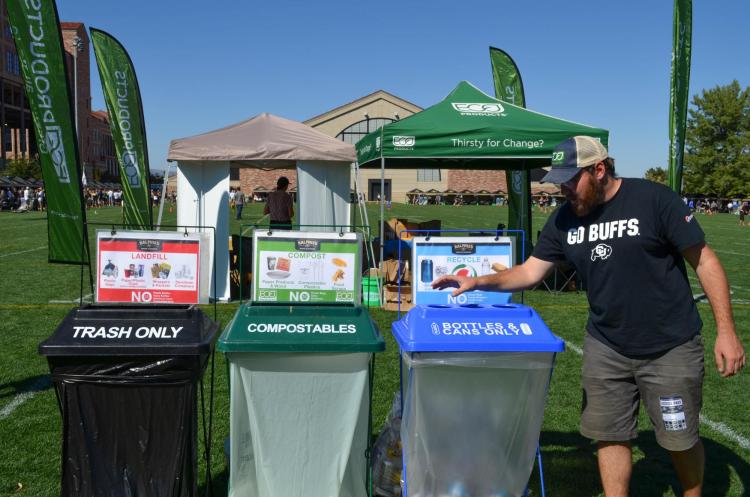Facilities Management accelerates compost collections expansion

CU Boulder Facilities Management has accelerated its efforts to integrate compost collections into all campus buildings by summer 2022, representing another important step toward the campus's goal of achieving a 90% waste-diversion rate by 2025. Compost is already being collected in 80 campus buildings.
During the 2018–19 fiscal year, campus compost collections diverted 841 tons of compostable material from the landfill—1,400 times the weight of Ralphie, CU Boulder’s live buffalo mascot. In addition, 88 percent of that material came from food waste composted in the Village Center Dining and Community Commons, Farrand Hall, Center for Community, Sewall Hall and the University Memorial Center.
While campus grounds teams have been collecting yard waste and tree trimming since the 1990s, food waste compost collection was started in 2004 and has steadily increased, more than doubling in non-food-service buildings in just the last four years alone. This expansion helped campus achieve a waste diversion rate exceeding 50% for the first time during the 2018 fiscal year, a feat achieved again during the 2019 fiscal year.
Collections in non-food-service buildings began as a pilot program in 2011, with campus bringing five additional buildings online per year in recent years as well as implementing collections in all new construction. Facilities Management’s (FM) compost collections rollout began accelerating last summer when FM took over collections for non-food-service buildings from an outside vendor, a move that reduced some of the cost and flexibility barriers limiting the timeline.
Compost is primarily collected in campus dining facilities and the restrooms of non-food-service buildings, though Facilities Management is piloting collections in kitchens and conference rooms of select non-food-service buildings. Compost collection is also available in the waste collection alcoves for all graduate and family housing facilities.
Additionally, compost is collected at zero waste events on campus throughout the year, including all home football and basketball games thanks to the efforts of Ralphie’s Green Stampede.
Learn what you can do to make your campus event zero waste.
Frequently asked questions
Why are most campus compost bins located in restrooms?
Locating compost bins in restrooms economizes custodial staff time spent collecting materials, takes advantage of the frequent air exchanges in those spaces, and ensures daily paper towel waste is composted. Food waste and all other compostables can be disposed of in these bins. If your building is interested in having a bin in its kitchen, it is recommended to locate a small bin there and empty it into restroom compost bins frequently. Compost "mini bins" are available by emailing cure@colorado.edu.
What goes in the compost bins?
Food scraps; used paper towels and tissues; and paper and plastic containers that say "compostable," have the compostable symbol, or say "#7 PLA." Compost contamination is costly to campus, so please educate yourself about which items are compostable.
When will my building get compost?
All remaining campus buildings are tentatively slated to have compost collections added by no later than the summer of 2022. Campus will bring about half of those buildings online during the 2020-21 academic year, with the rest being added during the 2021-22 academic year.
Why don’t all buildings just get it now?
There remain some added costs to adding compost to all buildings, and FM is committed to building up the program and budget to get collections to all buildings on campus as quickly as possible.


